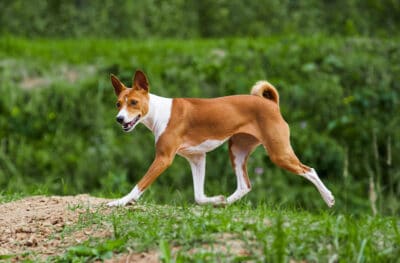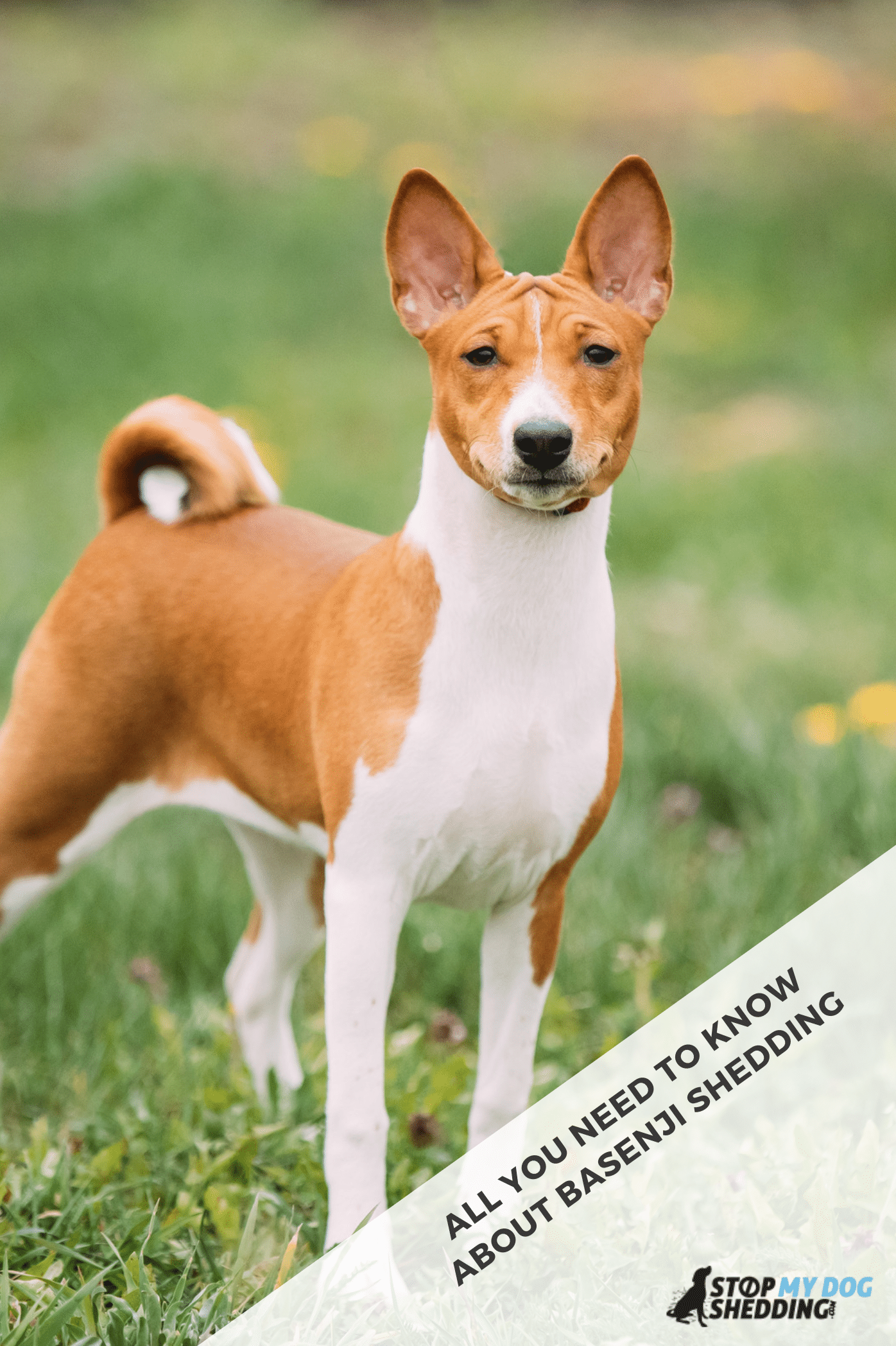Basenjis might be small in appearance, and they don’t bark much, but don’t let that fool you. They were originally bred as hunters in Africa, and they’re one of the most intelligent, courageous dogs out there. Not to mention, they are surprisingly powerful for their size!
How much hair do they shed?
Basenjis are considered a low-shedding breed.
Like most dogs, they do shed more during seasonal changes like Spring, but it’s not very noticeable given their short coat, and they’re very easy to groom. So Basenjis are well suited to anyone looking for a quiet, low maintenance, and low shedding dog.
In this article, we’ll take a closer look at Basenjis so that, if you do decide to adopt one of these guys, you’ll have a better idea of what to expect.
Basenji Shedding
Basenjis are a low-shedding breed. However, like most dogs, they do shed at least some hair, so you shouldn’t expect that your home is going to be completely hair free.
It’s just that, with Basenjis, the hair you will find floating around your home will typically be a lot less than with most other breeds.
Another thing worth mentioning is that Basenjis tend to shed more during seasonal changes, like spring and fall, which typically lasts for a couple of weeks as they “blow coat.”
This just means that they shed a little more, or in some cases, a lot more, for several weeks each year as their coat naturally sheds in preparation for the new season. However, given the short, fine hairs on his coat, this is hardly noticeable and quite easy to keep under control.
Basenji Coat Card

| Coat type: | Single coat |
| Texture: | Smooth |
| Length: | Short hair |
| Color: | Red, black, brindle, or tricolor with a white tail, feet, and chest |
| Shedding: | Low-shedding |
| Grooming: | Low-maintenance |
What Are They Like to Groom?
Basenjis are one of the easiest dogs to groom on the planet. And one of the main reasons for this is because of their short, smooth coat. Even with a full day out and about, mud and all, they are so easy to groom that a simple wipe down with a cloth is often sufficient.
When it comes to brushing, using a bristle brush or rubber brush once or twice a week should get the job done. The only caveat here is that some Basenjis have thicker coats, and not all dogs of the same breed will shed the same. So if you’re noticing lots of fur around the home, it may be worth using a de-shedding tool like the ones we discuss in this post.
In any case, the good thing about brushing regularly is that not only does it remove loose dead hairs from his coat, but it also helps to evenly spread the natural oils of his coat. And this, in turn, can help to prevent excessive shedding due to dry skin.
Another reason that Basenjis are such a low-maintenance breed is that they actually groom themselves in a similar manner to a cat. This is why some refer to them as being fastidious and even “cat-like” when it comes to keeping themselves clean.
And to top it off, they have an odorless coat, which means that even if you don’t bathe him for a while, his coat is unlikely to have that common “dog odor” smell as with other breeds.
Are Basenjis Hypoallergenic?
Basenjis are considered a “hypoallergenic breed” because they are less likely to cause an allergic reaction among allergy sufferers in comparison to other breeds. However, no dog is ever completely hypoallergenic, so it’s possible that ANY dog can trigger a reaction.
It’s important to understand that just because a dog sheds very little hair doesn’t mean it won’t upset your allergies. It definitely does make a difference, but the main problem is not the hair itself. It’s actually the dried saliva and dander (dead skin) that sticks to the hair.
And, when that hair falls out, the dander spreads around the home.
Even without the shedding aspect, however, dander can still find its way into the air, and so these allergens can still present a problem for those who suffer from pet-related allergies.
That said, Basenjis are very low shedding, and they are a notoriously clean breed that requires minimal maintenance. So, while no breed is ever 100% hypoallergenic, Basenjis may be more tolerable among allergy sufferers overall.
Keeping Shedding to a Minimum
There’s not a lot you need to do to keep shedding to a minimum since Basenjis don’t shed much, to begin with. A simple brush once per week with a regular bristle brush is all that’s required.
Not only will this remove any dead hairs on his coat, but it will help spread the oils of his coat evenly over the skin and hair, which helps keep shedding to a minimum.
With that being said, you may need to go further than this depending on the individual dog and during certain times of the year, such as autumn and spring.
And in that case, using a good quality de-shedding tool, in conjunction with regular bathing and ensuring your dog’s diet is optimal, can make all the difference.
If you want to know more, see our complete shedding guide. In it, we show you all you need to know about getting the shedding under control.
Should You Adopt a Basenji?
Basenjis make excellent family companions, especially for those wanting a low shedding, easy-to-groom dog that doesn’t bark. They’re affectionate, loving, and loyal to their humans.
They also make great watchdogs. This might sound strange given their size and the fact they’re known as the “barkless dog.” But they’re surprisingly powerful for their size and, even though they don’t bark, can still make plenty of noise!
You’ll typically hear pleasant yodels from a Basenji, but if trouble is around, they’ll typically let you know by way of a typical growl or howl, or in some cases, an all-out ear-piercing scream.
Basenjis are also a highly intelligent, curious, and energetic breed (one that tends to value their own independence over taking commands). So they can be a little stubborn and are probably not suited to someone who isn’t wanting to put much effort into training.
It’s entirely possible to train your Basenji to become a highly obedient dog, but they are more work than many other breeds in this respect. Mostly because they’re stubborn and like to do what is pleasing to them rather than their owner.
This is why playing fetch doesn’t always work out according to plan. They love to play, but not necessarily the way you want to (lol). So don’t be surprised if they wander off and get themselves into mischief if left unchecked!
What about leaving him at home during the day?
Basenjis are known to be quite destructive if left to their own devices, so it might pay to consider this before leaving him alone inside your house for extended periods of time.
And the story isn’t much better outside either. They’re very good at escaping fenced yards given their ability to climb, high energy levels, and sheer determination.
Bottom line… make sure you get proper obedience training early on and learn how to handle your Basenji, as this can make all the difference.
What’s Their History?
Basenjis are part of the American Kennel Club’s “hound group” classification, so they share similar traits to breeds like the Rhodesian Ridgeback and Afghan Hound.
They’re also one of the oldest breeds the AKC has on record, with their lineage dating all the way back to the days of ancient Egypt, where they were bought to pharaohs as gifts from Africa.
They get their reputation as hunting dogs because they were originally bred in the African Congo by local tribes to hunt small game. In some parts of Africa, the name Basenji means “wild dog” or “dogs of the savages,” while in other parts, it means “dog that jumps up and down.” Either way, the Basenji’s purpose was always the same, help tribespeople hunt.
This probably explains why they have a natural tendency to hunt cats, rabbits, and other small animals like squirrels, for example. And why they typically don’t mix well with other dogs unless socialized early on. They might be small, but they’re a force to be reckoned with.
In any case, the first Basenji entered Western society in the 19th century, but it wasn’t until the 1930s that they were officially accepted as a breed in England. And eventually, in 1944, they were successfully established in the United States.
Related Questions
Do Basenjis Smell?
Basenjis have an odorless coat. This means that even if you don’t bathe him for a while, his coat is not going to have that common “dog odor” smell as with other breeds.
Are Basenjis Good Family Dogs?
Basenjis make excellent family companions, especially for those wanting a low shedding, easy-to-groom dog that doesn’t bark. They’re affectionate, loving, and loyal to their humans.
Do They Bark Much?
No, Basenji’s do not bark because they have an unusually shaped larynx. However, they do yodel, howl, and whine like any other dog and can scream quite loudly to alert their owner.
Should Basenjis Be Left Alone?
Basenjis are definitely not the best dog to leave alone, given their destructive nature and their keen ability to jump and climb fences. This is why they need regular physical activity and stimulation to keep them from getting into mischief.
What Are Some Low Shedding Alternatives?
Other low shedding breeds that don’t bark much include the French Bulldog, Afghan Hound, and Chinook for example. But there are many other low-shedding breeds to consider, too.













How much do they cost
Generally speaking, puppies can cost between $1,000 to $2,000 or more. But it depends on numerous factors, such as where you live, what breeder you speak to, and whether the Basenji is purebred or not.
Are they good for walking and being with an older lady?
Hi. It depends on the individual dog and person, but generally speaking, Basenjis are high-energy dogs and aren’t always the easiest dogs to train, so there probably are better options for an older person.
If you’re looking for ideas, we’ve put together a list of low-shedding, lower-energy dogs that you might find helpful.
Also, the page about Basenjis on the American Kennel Club website that goes into more detail on the breeds traits.